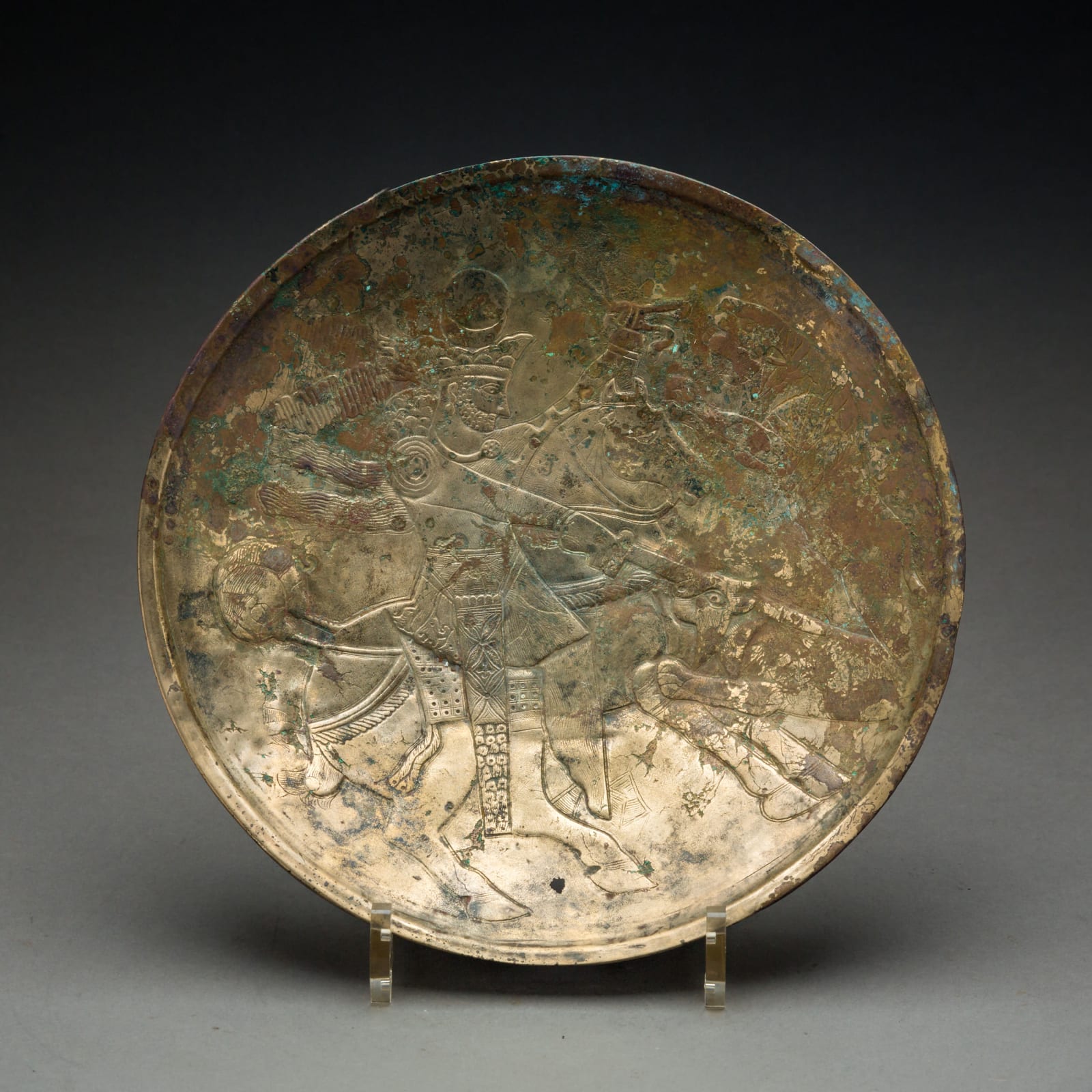Sassanian Plate with Royal Hunting Scene, c. 4th Century AD to 6th Century AD
Silver based alloy
height 26 cm
height 10 1/4 in
height 10 1/4 in
CB.864
This splendid plate bears a representation of one of the most famous iconographies in Sasanian Art: the royal hunting. A king rides fiercely his horse, while brandishing a lion cub...
This splendid plate bears a representation of one of the most famous
iconographies in Sasanian Art: the royal hunting. A king rides
fiercely his horse, while brandishing a lion cub in the upper hand.
The cub's parents are leaping toward the king: one rises fiercely,
while the other is being slain with a large sword.
The king is richly dressed and wears a complex crown with a
crescent and a sphere (symbolizing the moon and the sun). The shape
of the crown allows to propose an identification with Varahran V
(reigned AD 420-438, popularly known as Bahram Gur or Bahram V)
whose hunting exploits became legendary.
The general layout of the scene, with the double quarry, matches the
style and iconography of the second half of the fourth century and
first half of the fifth.
Another element to consider for a possible identification is the fact
that the iconography of the royal hunt becomes more common from
the reign of Shapur II (310–379 AD) onward.
The alloy appears to be mostly composed by silver, with a component
of copper (evidenced by traces of green oxidation). This is
comparable with known and published Sasanian alloys (cf. British
Museum 124092: analysed by XRF and suggested to have a silver
composition of 94.2 – 94.9%, copper content of 4.05 – 4.7%, and 0.5
– 0.7% gold).
The royal hunting was a very important motif in the iconography of
Sasanian rulers. This subject embodied visually the great might and
power of the kings, their ability to protect their kingdom in battle, and
their prowess at hunting (particularly important for kings such as
Bahram V –probably the subject represented on this plate- who
greatly favoured this sport). The subject is commonly represented on
silver vessels for the Sasanian elite, which could then show their
allegiance and link to the king. These plates were also sent often as
gifts to neighbouring courts.
An exceptionally close comparable, both for iconography and for the
features of the King (as identified by the crown) is a silver plate kept
at the British Museum (n. 124092) where the king was identified as
Bahram V.
Bibliography: Prudence Oliver Harper 1981, ‘Silver Vessels of the
Sasanian Period, Vol. 1: Royal Imagery’, Metropolitan Museum of
Art, published in association with Princeton University Press.
iconographies in Sasanian Art: the royal hunting. A king rides
fiercely his horse, while brandishing a lion cub in the upper hand.
The cub's parents are leaping toward the king: one rises fiercely,
while the other is being slain with a large sword.
The king is richly dressed and wears a complex crown with a
crescent and a sphere (symbolizing the moon and the sun). The shape
of the crown allows to propose an identification with Varahran V
(reigned AD 420-438, popularly known as Bahram Gur or Bahram V)
whose hunting exploits became legendary.
The general layout of the scene, with the double quarry, matches the
style and iconography of the second half of the fourth century and
first half of the fifth.
Another element to consider for a possible identification is the fact
that the iconography of the royal hunt becomes more common from
the reign of Shapur II (310–379 AD) onward.
The alloy appears to be mostly composed by silver, with a component
of copper (evidenced by traces of green oxidation). This is
comparable with known and published Sasanian alloys (cf. British
Museum 124092: analysed by XRF and suggested to have a silver
composition of 94.2 – 94.9%, copper content of 4.05 – 4.7%, and 0.5
– 0.7% gold).
The royal hunting was a very important motif in the iconography of
Sasanian rulers. This subject embodied visually the great might and
power of the kings, their ability to protect their kingdom in battle, and
their prowess at hunting (particularly important for kings such as
Bahram V –probably the subject represented on this plate- who
greatly favoured this sport). The subject is commonly represented on
silver vessels for the Sasanian elite, which could then show their
allegiance and link to the king. These plates were also sent often as
gifts to neighbouring courts.
An exceptionally close comparable, both for iconography and for the
features of the King (as identified by the crown) is a silver plate kept
at the British Museum (n. 124092) where the king was identified as
Bahram V.
Bibliography: Prudence Oliver Harper 1981, ‘Silver Vessels of the
Sasanian Period, Vol. 1: Royal Imagery’, Metropolitan Museum of
Art, published in association with Princeton University Press.
1
of
76
